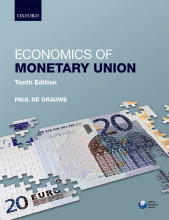European Financial Integration: Origins of History
17 important questions on European Financial Integration: Origins of History
The EU consists of 28 member states. It has its origins in the European Coal and Steel Community in 1951. What was its main objective?
What did the Maastricht Treaty entail?
What was initiated to protect monetary policy and ease up integration?
In 1999, the Financial Services Action Plan (FSAP) was launched to remove regulatory and market barriers that limit cross border provision of financial services and the free flow of capital within the EU
- Higher grades + faster learning
- Never study anything twice
- 100% sure, 100% understanding
Explain the two basic approaches towards integration and give a difference between them
an international institution that is independent from national governments, responsible for policy making > member states lose power to enact legislation
intergovernmental approach
international institution fulfils a secretariat role for the governments and has no real power > no sovereignty is transferred
difference: the transfer of sovereignty from the member states to that institution
Which legal instruments exist in the EMU?
2. directives: binding upon each member state to which it is addressed but gives national authorities the choice of form & methods.
What is the EMS and what is its core?
What did the 3 phase transition towards monetary unification look like?
2nd stage: the establishment of the European Monetary Institute. Independence of national central banks and the ban on the granting of CB credit to public sector
3rd stage: fixing of conversion rates, intro of the euro, single monetary policy, stability and growth pact
What is the task of the Governing Council of ECB?
Explain the Stability & Growth Pact
With the Maastricht Treaty and the SGP there are 2 arms. Explain the difference between them.
Corrective arm prevents gross policy errors
What are the TSCG and MIP?
Macroeconomic Imbalance Procedure: to monitor and prevent large macroeconomic and financial imbalances within the euro area
How did financial integration in the EMU take off?
2. Concerning financial services: a single licence and home country control for fin institiutions plus capital adequacy requirements
3. In 1999, FSAPs purpose was to remove regulatory & market barriers limiting the provision of fin services & capital across borders within the EU.
Which four objectives did the FSAP (Financial Services Action Plan) have?
2. open and secure retail markets
3. prudential rules and supervision with Capital Requirements Directive to ensure financial soundness
4. optimal single financial market addressing disparities in tax treatment and creating transparent legal system for corporate governance
Why is a decentralized system of bank supervision inadequate in EMU?
The European Council decided in 2010 for a European Banking Union, involving 4 elements. Which 4?
2. Single Supervisory Mechanism (SSM): microprudential supervision of banks has moved from national supervisors to ECB
3. the Single Resolution Mechanism (SRM) introduced to deal with bank resolution
4. a European deposit guarantee scheme has been introduced ensuring that deposits in all member states will be guaranteed up to 100.000 per depositor and bank
Give the main tasks of the following institutions: European Commission, ECB, SRB, ESM
ECB: financial supervision & LOLR
SRB (single resolution board): deposit insurance & resolution
ESM: fiscal backstop
What is the differnce between the Eurosystem and the ESCB?
Governing council, meet twice a month, interest rate decision
ESCB, European System of Central Banks = ECB + NCBs 28 EU member states
General Council, meet once every three months, non-euro area issues
The question on the page originate from the summary of the following study material:
- A unique study and practice tool
- Never study anything twice again
- Get the grades you hope for
- 100% sure, 100% understanding
































